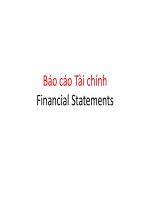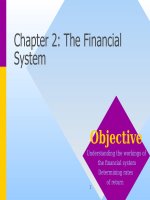Introduc corporate finance ch16
Bạn đang xem bản rút gọn của tài liệu. Xem và tải ngay bản đầy đủ của tài liệu tại đây (162.77 KB, 45 trang )
Chapter 16: Limits to the Use of
Debt
16.1 Costs of Financial Distress
16.2 Description of Costs
16.3 Can Costs of Debt Be Reduced?
16.4 Integration of Tax Effects and Financial Distress Costs
16.5 Shirking, Perquisites, and Bad Investments: A Note on
Agency Cost of Equity
16.6 The Pecking-Order Theory
16.7 Growth and the Debt-Equity Ratio
16.8 Personal Taxes
16.9 How Firms Establish Capital Structure
16.10 Summary and Conclusions
M&M Assumptions
Homogeneous expectations.
Homogeneous business risk classes.
Perpetual cash flows: V = CF/r.
Perfect capital markets
No market frictions:
corporate or personal taxes,
issue costs,
transactions costs,
costs of financial distress.
The Modigliani-Miller Capital
Structure Propositions
NO TAX CASE:
Proposition I:
Proposition II:
VL = VU
rS = r0 +(B/S)(r0-rB)
WITH CORPORATE TAXES:
Proposition I:
VL = VU + TCB
Proposition II:
rS = r0 +(B/SL)(1- TC) (r0-rB)
MM Theory with Taxes
VL = VU + TCB
implies firms should issue nearly all debt
financing.
Extensions
personal taxes
financial distress costs
Costs of Financial Distress
Bankruptcy risk versus bankruptcy cost.
The possibility of bankruptcy has a negative
effect on the value of the firm.
However, it is not the risk of bankruptcy itself
that lowers value.
Rather it is
bankruptcy.
It is the stockholders who bear these costs.
the
costs
associated
with
Costs of Financial Distress
Direct costs
Indirect costs
Financial distress costs result in an interior
solution in the determination of optimal
capital structure.
VL = VU + PV(tax savings)-PV(costs of
financial distress)
Costs of Financial Distress
Direct Costs
Legal and administrative costs
Indirect Costs
Impaired ability to conduct business (e.g., lost
sales)
Selfish strategy 1: Incentive to take large risks
Selfish strategy 2: Incentive toward
underinvestment
Selfish Strategy 3: Milking the property
Balance Sheet for a Company
in Distress
Assets
BVMVLiabilities
Cash
$200$200LT bonds
Fixed Asset$400 $0Equity
Total
$600$200Total $600
BVMV
$300
$300
$200
$200
$0
What happens if the firm is liquidated today?
The bondholders get $200; the shareholders get nothing.
Selfish Strategy 1: Take Large
Risks
The Gamble
Probability
Payoff
Win Big
Lose Big
10%
90%
$1,000
$0
Cost of investment is $200 (all the firm’s cash)
Required return is 50%
Expected CF from the Gamble = $1000 × 0.10 + $0
= $100
$100
NPV = −$200 +
NPV = −$133
1.50
Selfish Stockholders Accept Negative
NPV Project with Large Risks
Expected CF from the Gamble
To Bondholders = $300 × 0.10 + $0 = $30
To Stockholders = ($1000 - $300) × 0.10 + $0 = $70
PV of Bonds Without the Gamble = $200
PV of Stocks Without the Gamble = $0
PV of Bonds With the Gamble = $30 / 1.5 = $20
PV of Stocks With the Gamble = $70 / 1.5 = $47
Selfish Strategy 2:
Underinvestment
Consider a government-sponsored project that
guarantees $350 in one period
Cost of investment is $300 (the firm only has $200
now) so the stockholders will have to supply an
additional $100 to finance the project
Required return is 10%
$350
NPV = −$300 +
1.10
NPV = $18.18
•Should we accept or reject?
Selfish Stockholders Forego Positive
NPV Project
Expected CF from the government sponsored project:
To Bondholder = $300
To Stockholder = ($350 - $300) = $50
PV of Bonds Without the Project = $200
PV of Stocks Without the Project = $0
PV of Bonds With the Project = $300 / 1.1 = $272.73
PV of Stocks with the project = $50 / 1.1 - $100 = $54.55
Selfish Strategy 3: Milking the
Property
Liquidating dividends
Suppose our firm paid out a $200 dividend to the
shareholders. This leaves the firm insolvent, with
nothing for the bondholders, but plenty for the
former shareholders.
Such tactics often violate bond indentures.
Increase perquisites to shareholders
and/or management
Can Costs of Debt Be
Reduced?
Protective Covenants
Debt Consolidation:
If we minimize the
contracting costs fall.
number
of
parties,
Protective Covenants
Agreements to protect bondholders
Negative covenant: Thou shalt not:
Pay dividends beyond specified amount.
Sell more senior debt & amount of new debt is limited.
Refund existing bond issue with new bonds paying lower
interest rate.
Buy another company’s bonds.
Positive covenant: Thou shall:
Use proceeds from sale of assets for other assets.
Allow redemption in event of merger or spinoff.
Maintain good condition of assets.
Provide audited financial information.
Integration of Tax Effects and
Financial Distress Costs
There is a trade-off between the tax
advantage of debt and the costs of
financial distress.
It is difficult to express this with a precise
and rigorous formula.
Integration of Tax Effects and Financial
Distress Costs
Value of firm (V)
Value of firm under
MM with corporate
taxes and debt
Present value of tax
shield on debt
VL = VU + TCB
Maximum
firm value
Present value of
financial distress costs
V = Actual value of firm
VU = Value of firm with no debt
0
B*
Optimal amount of debt
Debt (B)
The Pie Model Revisited
Taxes and bankruptcy costs can be viewed as just another
claim on the cash flows of the firm.
Let G and L stand for payments to the government and
bankruptcy lawyers, respectively.
VT = S + B + G + L
S
B
L
G
The essence of the M&M intuition is that VT depends on the
cash flow of the firm; capital structure just slices the pie.
Pie Again
VT = S + B + G + L = V M + V N
VM= marketed claims = debt and equity.
VN= non-marketed claims
= tax liabilities G plus other claimants L
such as potential lawsuits or pension fund
liabilities.
any change in the size of one piece of the pie
must be offset by a change in the size of one or
more of the other pieces.
the manager’s objective is to maximize the value
of the marketed claims while minimizing the value
of the non-marketed claims.
Example
1986:
Pennzoil was awarded $10.3 billion from
Texaco by Texas courts because of
Texaco’s interference with Pennzoil’s effort
to acquire the assets of Getty Oil Co.
Texaco filed for Chapter 11 reorganization
in attempt to shield the equity shareholders
from this onerous non-marketed claim.
Free Cash Flow Hypothesis
An individual will work harder for a firm if he is one of the
owners than if he is one of the “hired help”.
Who bears the burden of these agency costs?
While managers may have motive to partake in
perquisites, they also need opportunity. Free cash flow
provides this opportunity.
The free cash flow hypothesis says that an increase in
dividends should benefit the stockholders by reducing
the ability of managers to pursue wasteful activities.
The free cash flow hypothesis also argues that an
increase in debt will reduce the ability of managers to
pursue wasteful activities more effectively than dividend
increases.
The Pecking-Order Theory
Theory stating that firms prefer to issue debt
rather than equity if internal finance is insufficient.
Rule 1
Rule 2
Use internal financing first.
Issue debt next, equity last.
The pecking-order theory is at odds with the
trade-off theory:
There is no target D/E ratio.
Profitable firms use less debt.
Companies like financial slack
Growth and the Debt-Equity
Ratio
Growth
implies
significant
equity
financing, even in a world with low
bankruptcy costs.
Thus, high-growth firms will have lower
debt ratios than low-growth firms.
Growth is an essential feature of the real
world; as a result, 100% debt financing is
sub-optimal.
Personal Taxes: The Miller
Model
The Miller Model shows that the value of a levered firm
can be expressed in terms of an unlevered firm as:
(1 − TC ) × (1 − TS )
VL = VU + 1 −
× B
1 − TB
Where:
TS = personal tax rate on equity income
TB = personal tax rate on bond income
TC = corporate tax rate
Personal Taxes: The Miller Model
(cont.)
(1 − TC ) × (1 − TS )
VL = VU + 1 −
× B
1 − TB
• In the case where TB = TS, we return to M&M with
only corporate tax:
VL = VU + TC B









